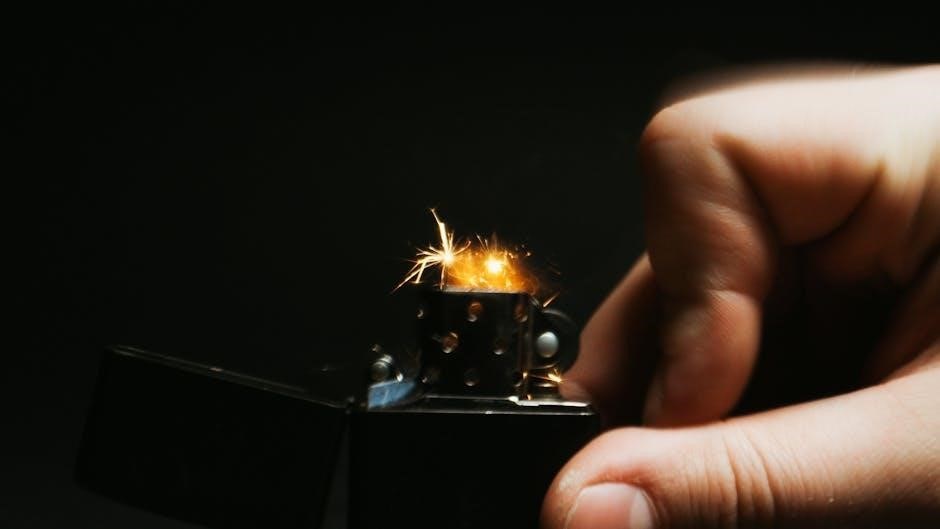The Kindle Fire HD 10 manual is a comprehensive guide to mastering your device’s features, from initial setup to navigating apps and media consumption. It covers accessibility, customization, and more, ensuring both new and experienced users can optimize their experience.
1.1 What is the Kindle Fire HD 10?
The Kindle Fire HD 10 is a versatile tablet designed by Amazon for media consumption, reading, and entertainment. It features a 10.1-inch HD display, making it ideal for streaming videos, browsing the web, and enjoying e-books. The device runs on Amazon’s Fire OS, which provides a user-friendly interface tailored for Amazon services like Prime Video, Kindle, and Alexa. With its sleek design and robust features, the Kindle Fire HD 10 is a popular choice for users seeking an affordable yet powerful tablet for everyday use. It supports a wide range of apps, offers impressive battery life, and includes accessibility features to enhance usability for all users.
- 10.1-inch HD display for vibrant visuals
- Optimized for Amazon services and content
- Lightweight and portable design
- Integrated Alexa for voice commands
- Customizable home screen and settings
Whether for reading, streaming, or apps, the Kindle Fire HD 10 delivers a seamless experience tailored to your needs.
1.2 Device Specifications
The Kindle Fire HD 10 boasts a 10.1-inch HD display, offering crisp visuals for movies, books, and apps. It is powered by a quad-core processor, ensuring smooth performance for everyday tasks. The device comes in storage options of 32GB or 64GB, with the ability to expand storage via a microSD card. It features 3GB of RAM, providing efficient multitasking capabilities. The tablet supports Wi-Fi connectivity for seamless internet access and weighs approximately 465 grams, making it portable and easy to handle. Battery life is robust, lasting up to 10 hours on a single charge. The Fire HD 10 also includes a 5MP rear camera and a 2MP front camera for basic photography needs. With dimensions of 247 x 155 x 9.2 mm, it is designed for comfort and convenience, catering to both entertainment and productivity.
- 10.1-inch HD display
- Quad-core processor
- 32GB or 64GB storage options
- 3GB RAM
- Wi-Fi connectivity
- Up to 10 hours of battery life
- 5MP rear camera, 2MP front camera
- Dimensions: 247 x 155 x 9.2 mm

These specifications ensure a balanced and enjoyable user experience for media consumption, reading, and light productivity.

Device Overview
The Kindle Fire HD 10 offers a vibrant HD display, seamless Alexa integration, and a wide range of apps for entertainment and productivity, making it a versatile and user-friendly device.
2.1 Hardware Components
The Kindle Fire HD 10 features a 10.1-inch HD display, offering vibrant visuals for media consumption. It is equipped with a robust battery life, supporting up to 12 hours of continuous use. The tablet includes a 3.5mm audio jack, USB-C port for charging, and dual-speaker systems with Dolby Atmos for enhanced sound quality. The front and rear cameras enable video calls and photography, while the lightweight design ensures portability. Storage options vary, with models offering 32GB or 64GB of internal storage, expandable via microSD cards. The device also supports wireless connectivity, including Wi-Fi and Bluetooth, ensuring seamless integration with other devices and services. These hardware components collectively provide a balanced blend of performance and portability, catering to both entertainment and productivity needs.
2.2 Software Overview
The Kindle Fire HD 10 operates on Amazon’s Fire OS, a customized version of Android, designed to integrate seamlessly with Amazon services like Prime Video, Amazon Music, and Alexa. The operating system offers a user-friendly interface tailored for content consumption, with easy access to Amazon’s ecosystem of apps, books, and media. Fire OS supports popular apps from the Amazon Appstore, enabling users to enhance functionality beyond core features. It also includes accessibility tools like VoiceView, a screen reader for visually impaired users. Regular software updates ensure security and performance improvements. The platform is optimized for smooth navigation, allowing users to switch between apps, manage media libraries, and utilize Alexa for voice commands. This blend of simplicity and functionality makes the Fire OS a versatile choice for both entertainment and productivity.

Setting Up the Device
Unbox your Kindle Fire HD 10, connect to Wi-Fi, and follow on-screen instructions for first-time setup. Register your device to access Amazon services and begin exploring its features.
3.1 Unboxing and Accessories
Upon unboxing your Kindle Fire HD 10, you’ll find the tablet, a USB cable, and a power adapter. Ensure all items are included and undamaged. The device may also include a quick start guide to help you get started. For enhanced functionality, consider Amazon-recommended accessories like cases, screen protectors, or wireless charging docks, especially for the 11th Generation models. These accessories can be purchased separately and are designed to complement your user experience. Always use Amazon-approved chargers to ensure compatibility and safety. Properly store the included accessories to maintain their condition and prevent loss. If any items are missing or damaged, contact Amazon support promptly for assistance.

3.2 First-Time Setup
When you first power on your Kindle Fire HD 10, follow the on-screen instructions to begin the setup process. Select your preferred language and connect to a Wi-Fi network. You may be prompted to choose a device name for easier identification. Next, sign in with your Amazon account or create a new one if you don’t have one; Registration is essential to access Amazon services like the Appstore, Kindle books, and other features. If you’re setting up for a child, you can create a Amazon Kids+ profile with parental controls. After registration, the device will download and install any available updates. Once complete, you’ll be taken to the home screen, where you can start exploring your device. Ensure all steps are completed to fully activate and customize your Kindle Fire HD 10.
3.3 Connecting to Wi-Fi
To connect your Kindle Fire HD 10 to Wi-Fi, go to the device’s settings menu. Select the “Wi-Fi” option and toggle it on. Choose your desired network from the list of available options. If prompted, enter the network password to complete the connection. Ensure the network is stable and within range for optimal performance. Once connected, you’ll have access to internet-based features like app downloads, streaming, and browsing. If you encounter issues, restart your router or check the network password. For further assistance, refer to the troubleshooting tips in the manual.
3.4 Registering Your Device
Registering your Kindle Fire HD 10 is essential to access all its features, including Amazon services like Kindle Unlimited, Amazon Music, and more. To register, ensure your device is connected to Wi-Fi. Open the Settings menu, select “Account & Lists,” and choose “Register Device;” Sign in with your Amazon account credentials or create a new account if you don’t have one. Once registered, you’ll gain full access to Amazon’s ecosystem, including personalized recommendations and cloud-based content. If you’re setting up the device for a child, you can register it under a parent’s Amazon account and later manage permissions through Amazon Family Library. For troubleshooting registration issues, refer to the device’s manual or contact Amazon Support for assistance.

Navigation and Basic Operations
The Kindle Fire HD 10 features an intuitive interface with gesture-based navigation. Swipe left/right to switch between screens, and tap to select apps or content. Access settings by swiping down from the top.
4.1 Home Screen Overview
The Kindle Fire HD 10’s home screen is your central hub for navigation and content access. It features a clean, user-friendly interface with a navigation bar at the top for quick access to the web browser, library, and apps.
The home screen is divided into sections, including Books, Video, Music, and Apps, allowing easy access to your content. The For You section offers personalized recommendations based on your usage and preferences.
At the bottom of the screen, you’ll find the Status Bar, which displays connectivity, battery life, and time. You can customize the home screen by adding favorite apps or rearranging content to suit your needs.
This intuitive layout ensures that you can quickly access your favorite features and content, making the Kindle Fire HD 10 a seamless and enjoyable device to use.
4.2 Gestures and Navigation
Navigating the Kindle Fire HD 10 is intuitive, thanks to its responsive touch screen and gestures. Common gestures include swiping left or right to move between pages, tapping to select items, and pinching to zoom in or out. To access settings or notifications, swipe down from the top of the screen. Use swipe up to return to the home screen from within an app.
The device also supports split-screen viewing for multitasking, accessible by swiping from the left edge. Additionally, users can enable Alexa hands-free by swiping down from the top and selecting the Alexa icon. These gestures make navigation seamless and enhance the overall user experience.
Mastering these simple gestures allows users to efficiently navigate and utilize the full potential of their Kindle Fire HD 10.
4.3 Customizing the Home Screen
Customizing the Kindle Fire HD 10 home screen allows users to tailor their experience to their preferences. You can add shortcuts to frequently used apps, organize apps into folders, and adjust the layout for easy access. To customize, long-press on an empty area of the screen or an app icon to access options like Add to Favorites or Move to Folder.
Users can also enable or disable features like Recent Items or Favorites by swiping down from the top of the screen and selecting Settings. Additionally, the home screen can be personalized with wallpapers and themes for a unique look. These customization options enhance productivity and aesthetics, making the device more user-friendly.
By organizing and personalizing the home screen, users can streamline their workflow and enjoy a more intuitive experience with their Kindle Fire HD 10.
4.4 Basic Operations
Mastering basic operations on the Kindle Fire HD 10 ensures a smooth user experience. Navigating the interface involves swiping left or right to scroll through content and tapping to select items. Users can open apps by tapping their icons or accessing them from the App Library. To switch between apps, swipe up from the bottom of the screen to view recently used apps. Adjusting screen brightness and volume can be done via the Quick Settings panel, accessed by swiping down from the top.
Accessing notifications is also done by swiping down from the top. Users can close apps by swiping them away in the multitasking view. These simple gestures and operations make using the Kindle Fire HD 10 intuitive and efficient for all users.

Features and Functionality
The Kindle Fire HD 10 offers Alexa integration, enabling voice commands, and supports app management for easy access to your favorite apps. It also features media consumption with support for various file formats and accessibility features like VoiceView for visually impaired users.
5.1 Alexa Integration
Alexa integration on the Kindle Fire HD 10 enhances your experience with voice commands, enabling hands-free control. To activate Alexa hands-free, swipe down from the top of the home screen and select the Alexa Hands-Free icon. This feature allows you to ask questions, shop, play music, and control smart home devices. Voice commands simplify navigation and multitasking. Additionally, Alexa supports accessibility features like VoiceView, a screen reader for visually impaired users. This integration makes the device more versatile and user-friendly, offering seamless interaction and enhancing productivity. The ability to use Alexa directly from the tablet adds convenience, making it a powerful tool for everyday tasks and entertainment.
5.2 App Management
Managing apps on your Kindle Fire HD 10 is straightforward and intuitive. You can download and install apps from the Amazon Appstore, which offers a wide range of options tailored for your device. Once installed, apps appear on the home screen, where you can organize them into folders or prioritize them for easy access. Regular updates ensure your apps stay functional and secure. The device also allows you to manage storage by uninstalling unused apps or moving data to external storage. This feature helps maintain performance and keeps your tablet clutter-free. By organizing and updating your apps effectively, you can enhance your user experience and make the most of your device’s capabilities.
5.3 Media Consumption
The Kindle Fire HD 10 excels at media consumption, offering a 10.1-inch display with vibrant colors and clear visuals, making it ideal for streaming videos, browsing photos, and reading. Amazon Prime members can access a vast library of movies, TV shows, and music directly through the device. The tablet supports popular formats like MP4, VP8, and MP3, ensuring compatibility with various media files. Additionally, the Amazon Music, Kindle Unlimited, and Audible services integrate seamlessly, providing endless entertainment options. The device also features a 3.5mm headphone jack, enhancing your audio experience. Whether you’re streaming content or enjoying locally stored media, the Fire HD 10 delivers an immersive experience, perfect for entertainment on the go.

5.4 Accessibility Features
The Kindle Fire HD 10 offers a range of accessibility features to ensure ease of use for everyone. VoiceView, a built-in screen reader, assists users who are blind or visually impaired by providing audio descriptions of on-screen content. Users can also adjust text size and enable High Contrast Mode for better readability. Additionally, the device supports Alexa hands-free mode, allowing voice commands for navigation and tasks. These features, combined with compatibility for users with physical or reading disabilities, make the Fire HD 10 an inclusive and user-friendly device.

Advanced Settings and Customization
Customize your Kindle Fire HD 10 with advanced settings to optimize performance. Adjust display brightness, manage notifications, and enhance battery life through tailored preferences for a personalized experience.
6.1 Display Settings
The Kindle Fire HD 10 offers extensive display customization options. Adjust brightness manually or enable auto-brightness for optimal visibility in different lighting conditions. The screen’s color temperature can also be fine-tuned. Additionally, font sizes can be adjusted for reading comfort, ensuring text is clear and easy to read. Users can also customize the screen’s orientation and enable features like auto-rotate for seamless transitions between portrait and landscape modes. Furthermore, the device provides options to enhance visual accessibility, such as enabling high contrast mode or adjusting display brightness levels for better readability. These settings allow users to tailor their viewing experience to suit their preferences and needs, ensuring a comfortable and enjoyable interaction with the device.
6.2 Notification Management
The Kindle Fire HD 10 allows users to manage notifications efficiently. Access the notifications drawer by swiping down from the top of the screen; In the Settings app, under Notification settings, you can toggle notifications on or off, adjust notification priorities, and customize alert styles. Additionally, users can enable or disable specific app notifications to reduce clutter. The device also supports Do Not Disturb mode, which can be scheduled or activated manually to silence notifications during specific times. Furthermore, notification sounds and badges can be personalized to enhance user experience. These features ensure users stay informed without unnecessary interruptions, providing a tailored approach to notification management.
6.3 Battery Optimization
The Kindle Fire HD 10 offers various features to optimize battery life. Enable Power-Saving Mode to reduce background data usage and limit performance. Adjust screen brightness and set an auto-brightness feature to conserve energy. Turn off Bluetooth and Wi-Fi when not in use to minimize power consumption. Additionally, the device provides detailed battery usage statistics to identify and limit power-hungry apps. Users can also schedule automatic screen timeouts and disable unnecessary animations. Regular software updates often include battery efficiency improvements. By customizing these settings, users can extend their device’s battery life, ensuring longer usage between charges. These tools help users manage their power consumption effectively, balancing performance and efficiency according to their needs.
6.4 Storage Management
The Kindle Fire HD 10 offers several tools to manage storage effectively. Users can check available storage in Settings under the Storage section, which displays usage by apps, media, and system files. Regularly deleting unused apps, clearing app caches, and removing downloaded content can free up space. The device supports microSD cards for expandable storage, allowing users to store more media and apps. Additionally, Amazon’s cloud storage integrates seamlessly, enabling users to offload files and access them remotely. To optimize further, disable automatic downloads and enable the “Download to SD card” option for apps and media. Periodically reviewing and organizing files ensures efficient use of internal and external storage, maintaining device performance and user experience. These features help users maximize their storage capacity and keep their device clutter-free.

Troubleshooting and Maintenance
Troubleshoot common issues like screen freezes or Wi-Fi problems by restarting your device or clearing app data. Regularly update software and clean the screen to maintain performance and functionality.
7.1 Common Issues and Solutions
Troubleshooting the Kindle Fire HD 10 often involves addressing common issues such as screen freezes, Wi-Fi connectivity problems, or battery life concerns. For screen freezes, restart the device by holding the power button for 20 seconds. Wi-Fi issues can be resolved by restarting your router or forgetting and re-connecting to your network. Battery life can be optimized by adjusting screen brightness, closing unused apps, and enabling power-saving modes. Additionally, ensure your device is updated to the latest software version, as updates often fix bugs and improve performance. If issues persist, resetting the device to factory settings may be necessary, but remember to back up your data first. Regular maintenance, such as clearing cached data and managing storage, can also prevent many common problems.
7.2 Updating Software
Updating your Kindle Fire HD 10 ensures you have the latest features and security improvements. To check for updates, go to Settings, then System, and select “System Update.” If an update is available, download and install it. Ensure your device is connected to Wi-Fi and has enough battery life or is plugged in. The update process may take a few minutes and could require a restart. Automatic updates are enabled by default, but you can manually check for updates at any time. If you encounter issues during an update, restart your device or reset it to factory settings as a last resort. Always back up your data before performing updates to avoid data loss. Regular software updates are essential for maintaining optimal performance and functionality of your Kindle Fire HD 10.
7.3 Resetting the Device
Resetting your Kindle Fire HD 10 can resolve software issues or prepare it for a new user. A factory reset erases all data, returning the device to its original settings. To perform a factory reset, go to Settings > System > Reset Device > Factory Reset. Ensure your device is fully charged or plugged in, as the process may take a few minutes. Before resetting, back up important data to Amazon Drive or an external storage device. Once completed, the device will restart and display the setup screen. For minor issues, a soft reset (restarting the device) may suffice. Resetting is a useful troubleshooting step for persistent problems or if you plan to sell or gift the device. Always proceed with caution and ensure all important files are backed up before proceeding with a factory reset.
7.4 Cleaning and Maintenance
Regular cleaning and maintenance are essential to keep your Kindle Fire HD 10 in optimal condition. Start by turning off the device and using a soft, dry cloth to wipe the screen and exterior surfaces. Avoid using harsh chemicals, aerosol cleaners, or abrasive materials, as they may damage the display or harm the device’s finish. For stubborn smudges, lightly dampen a microfiber cloth with water, but ensure it is not soaking wet to prevent moisture damage. Avoid exposing the device to extreme temperatures or direct sunlight for prolonged periods. For internal maintenance, regularly clear unused apps and files to free up storage space. Update your software periodically to ensure the device runs smoothly. Use a screen protector to prevent scratches and fingerprints. By following these steps, you can extend the lifespan of your Kindle Fire HD 10 and maintain its performance and appearance.